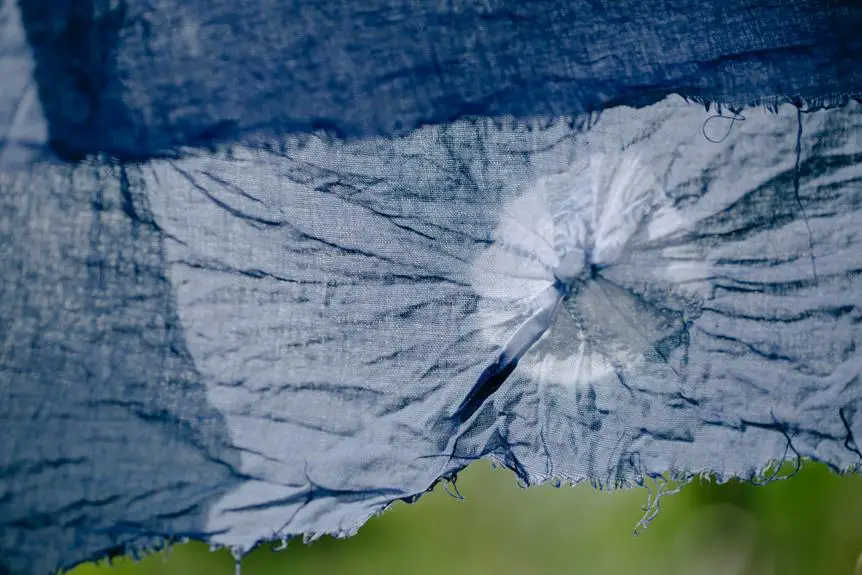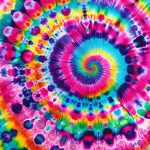Explore 5 must-try mandala tie dye patterns for vibrant fabrics. Each pattern offers a unique blend of symmetry and color, creating captivating designs that are sure to elevate your fabric projects.
These techniques are both intricate and visually striking, allowing you to achieve stunning results with precision and skill. Whether you're a seasoned tie dye enthusiast or just starting out, mastering these mandala patterns will add a new dimension to your fabric creations.
From the classic mandala spiral to the mesmerizing rainbow swirl variation, these patterns offer endless possibilities for creating vibrant, eye-catching textiles.
Embrace the artistry and precision of these mandala tie dye patterns to enhance your fabric projects with stunning, intricate designs.
Key Takeaways
- Preparation and techniques such as washing the fabric and employing folding techniques are essential for creating vibrant mandala tie-dye patterns.
- Color selection and symbolism play a crucial role in achieving visually captivating designs, with contrasting colors and lotus flower symbolism representing purity and rebirth.
- Dye application techniques, like saturating the fabric thoroughly and applying different colors to each section, are key to creating intense and geometric patterns.
- Securing and setting the fabric is important to prevent color bleeding and maintain the shapes of the folds, allowing the dye to set before rinsing and washing the fabric.
Classic Mandala Spiral Pattern
How can you achieve the classic mandala spiral pattern using tie dye techniques?
To create this iconic design, start by preparing your fabric. Use 100% natural fiber fabrics like cotton, as they absorb the dye best. Wash the fabric to remove any sizing or finishes that may hinder dye absorption.
Once the fabric is prepped, it's time to consider color combinations. For the classic mandala spiral, opt for contrasting colors like blue and yellow, or purple and orange, to achieve a vibrant and visually striking result.
To start the dyeing process, fold the fabric in half and then in half again to find the center point. From there, spiral the fabric into a tight coil, ensuring that the folds are even. Use rubber bands to secure the fabric in place, creating segments for the dye.
With the fabric prepared and secured, apply the chosen color combinations to each section of the spiral. The key is to saturate the fabric thoroughly with the dye to achieve intense, rich colors.
Once dyed, allow the fabric to set for the recommended time before rinsing and unveiling your classic mandala spiral pattern.
Lotus Flower Mandala Design
To achieve the Lotus Flower Mandala Design using tie dye techniques, you can continue exploring vibrant color combinations and intricate folding methods for a visually captivating result. The lotus flower holds significant symbolism in various cultures, representing purity, enlightenment, and rebirth. Incorporating this symbolism into your tie dye designs can add depth and meaning to your creations. When creating the Lotus Flower Mandala Design, consider using a mix of bold and soft colors to emulate the petals of the lotus flower. Additionally, the folding techniques play a crucial role in achieving the intricate patterns of the lotus flower. Below is a table outlining the intricate folding methods for creating the Lotus Flower Mandala Design:
| Folding Technique | Description |
|---|---|
| Sunburst Fold | Radiating folds from the center for a petal-like effect |
| Accordian Fold | Alternating accordion folds to create layers and depth |
| Twist and Bind Technique | Twisting sections and securing with bands for a spiral effect |
Sunburst Mandala Tie Dye Technique
To achieve the Sunburst Mandala tie dye technique, gather a variety of vibrant colors and master the radial folding method for a striking petal-like effect.
Start by folding the fabric in half and then in half again to create a smaller square. From the center of the fabric, begin folding it in a radial pattern, similar to how you'd fold a paper snowflake.
Once folded, apply different colors to each section created by the folds. Then, carefully wrap rubber bands around the fabric to secure the folds and prevent the colors from bleeding into each other.
Finally, apply the dye using the sunburst dyeing process, radiating from the center outwards to create a stunning mandala color blending effect.
- Utilize vibrant and contrasting colors for a bold and eye-catching result.
- Experiment with different folding techniques to create unique patterns within the mandala design.
- Ensure the dye penetrates through all layers of the fabric for a fully saturated finish.
- Use a color wheel to guide your color choices and achieve harmonious color combinations.
- Practice on small swatches of fabric before attempting larger projects to perfect your technique.
Geometric Mandala Symmetry
Achieve mesmerizing geometric mandala symmetry by implementing precise folding and dye application techniques. When creating geometric mandala patterns, precise folding is essential to ensure symmetry. Start by folding the fabric into halves or quarters, then use precise accordion folds to create geometric patterns such as triangles, squares, or hexagons. Secure the folds tightly with rubber bands to maintain the geometric shapes during the dyeing process.
Color coordination plays a crucial role in enhancing the geometric mandala symmetry. Consider using complementary or analogous color schemes to create visually striking patterns. For instance, if you're aiming for a bold and vibrant mandala, opt for complementary colors such as blue and orange, or purple and yellow. Alternatively, for a harmonious and soothing design, choose analogous colors like blue, green, and purple.
To maintain geometric symmetry, apply the dye methodically, ensuring each section receives the intended colors consistently. This precision will accentuate the geometric patterns and result in a stunning, balanced mandala design.
Rainbow Swirl Mandala Variation
Explore creating a vibrant Rainbow Swirl Mandala Variation by carefully layering and blending an array of bold and contrasting colors in your tie-dye designs. Achieve stunning results by mastering this colorful dye and fabric technique.
Here's how to create this captivating mandala variation:
- Start with a prepared fabric and lay it flat on a protected surface.
- Pinch the center of the fabric and twist it into a tight spiral, creating the mandala base.
- Apply the colorful dye in a circular motion, starting from the center and working outward in a rainbow spectrum.
- Use fabric techniques like folding, pleating, or scrunching to add depth and dimension to the design.
- Allow the dye to set for the recommended time, then rinse and wash the fabric according to the dye instructions.
Mastering the Rainbow Swirl Mandala Variation requires precision and an understanding of how to manipulate the colorful dye and fabric to achieve the desired effect. With practice and attention to detail, you can create vibrant and dynamic tie-dye pieces that showcase your mastery of this stunning mandala variation.
Frequently Asked Questions
What Type of Dyes and Materials Work Best for Achieving Vibrant Colors in Mandala Tie Dye Patterns?
For vibrant mandala tie dye patterns, use fiber-reactive dyes like Procion MX for cotton and silk, and acid dyes for wool. Effective folding techniques like accordion or spiral ensure even color distribution, delivering stunning results on your fabrics.
Are There Any Specific Folding Techniques That Can Help Create More Intricate Mandala Designs?
To create intricate designs in mandala tie dye, experiment with various folding techniques. Fabric manipulation is key to achieving unique patterns. Try accordion or fan folds for radial symmetry, or experiment with pleating for more complex designs.
How Can I Ensure That My Mandala Tie Dye Patterns Are Colorfast and Won't Fade After Washing?
To ensure colorfast mandala tie dye patterns, use professional dyeing methods and follow fabric care guidelines. Choose quality dyes, pre-treat the fabric, and wash with cold water and color-safe detergent. Avoid direct sunlight to prevent fading.
Are There Any Tips for Creating Larger Mandala Designs on Fabrics Like Tapestries or Bedspreads?
To create large mandala designs on fabrics like tapestries or bedspreads, consider using a larger work surface and expanding your mandala patterns. Utilize tips for tapestry tie dye and bedspread dye techniques to achieve vibrant and intricate designs.
Can Mandala Tie Dye Patterns Be Achieved on Different Types of Fabrics, Such as Silk or Linen, and Are There Any Specific Considerations for Dyeing These Materials?
You can achieve mandala tie dye patterns on various fabrics like silk or linen. Consider the fabric type and specific dyeing materials. Silk dyeing requires delicate handling to preserve its texture, while linen needs thorough pre-washing for optimal dye absorption.
- What Temperature Is Needed to Thermoform Nonwoven Polyester? - July 11, 2025
- How to Connect Rolls of Nonwoven Geotextile End-to-End - July 11, 2025
- The Pros and Cons of Nonwoven Polypropylene Bags - July 11, 2025





